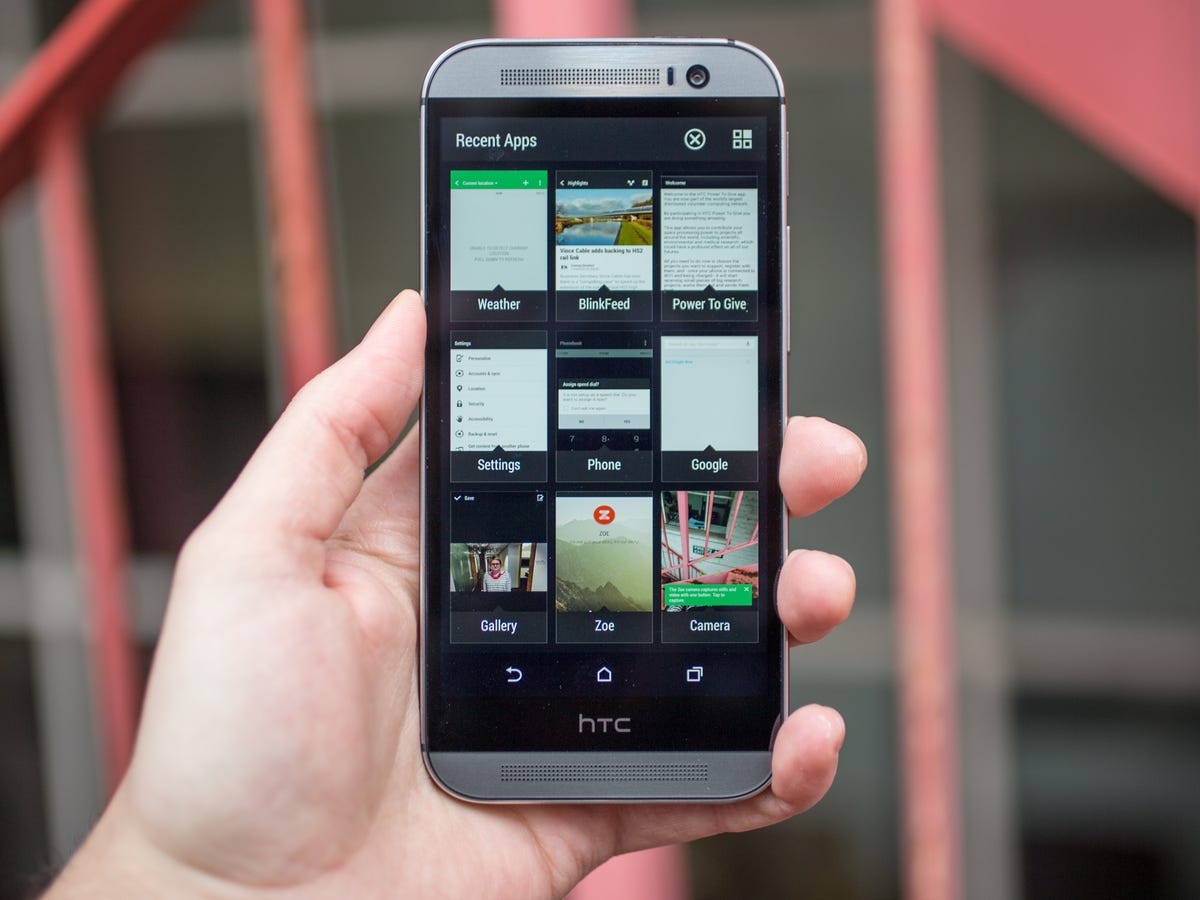
Andrew Hoyle/CNET
There was unfinished business with the HTC One.
It was critically praised, yes. In a sea of bland plastic phones, the HTC One’s aluminum-clad body stood out like a Mercedes Benz flanked by Toyota Camrys. One touch, and you couldn’t help but to think “premium.”
Yet to Scott Croyle, who heads up design for HTC, the company could do better. In fact, three months before the original HTC One even launched, Croyle was already getting the wheels turning on improving the unique construction by adding more metal to the successor phone.
The result: the HTC One M8, a more understated, but refined update of the original phone that was unveiled on Tuesday. It’s a thing of beauty, its trademark metal backing extended to wrap around the sides and up to the glass, arcing with the graceful curve of an aircraft wing.
“We really tried to achieve this beauty through craftsmanship,” Croyle said in an interview with CNET.
More on the HTC One
- HTC One M8 review: A stunning sequel
- Pictures: The sleek, metallic HTC One M8
- HTC One M8 camera very hit or miss
- HTC One M8 vs. Galaxy S5 vs. iPhone 5S
- HTC One M8 vs. original HTC One
The pressing question, of course, is will any of it even matter?
Once a high-flyer in the mobile world pushing the industry with innovative designs — it was the company that created the first Android phone, the G1 — HTC has long since ceded any semblance of a leadership role to Samsung Electronics, whose own powerhouse Galaxy S franchise sits alongside Apple’s blockbuster iPhone atop the smartphone food chain. Its star having faded considerably over time, HTC’s core dilemma can be summed up this way: it makes great phones, but few people tend to notice them.
HTC even opted last year to copy Samsung’s strategy of creating a single flagship phone to rally behind. The company insists the One is its best-selling phone ever, but it didn’t do much to reverse slumping sales or prevent the company from posting its first quarterly loss as a public company in October. Only the sale of its stake in Beats Electronics saved it from posting a second consecutive loss in the fourth quarter.
The success or failure of the M8 will play an even more critical role in HTC’s fate. At stake is the direction of the company’s financial health, which continues to sit in a precarious position. Moreover, just how consumers take to the M8 could dictate whether it can hang on to its role as a maker of aspirational, high-end mobile products, or if it eventually fades into the crowd of countless faceless phone vendors. Worse off, it could end up going the way of Palm or Nokia, getting scooped up by a larger competitor.
“Are they going to be a premium smartphone vendor or not? This is the phone that dictates that,” said Maribel Lopez, an analyst at Lopez Research.
Even as larger conglomerates such as LG, Lenovo, and Huawei have gained market share over the past year, HTC has slipped in the rankings, often shoved into the “other” category of companies that no longer warrant mention. To be exact, it held 1.8 percent of the global market in the fourth quarter, down from 3.2 percent a year ago, according to Gartner. Samsung, in comparison, controlled nearly a third of the market.
Making it worse, HTC already spends a paltry amount next to its competitors.
Check out the sleek, metal HTC One M8 (photos)
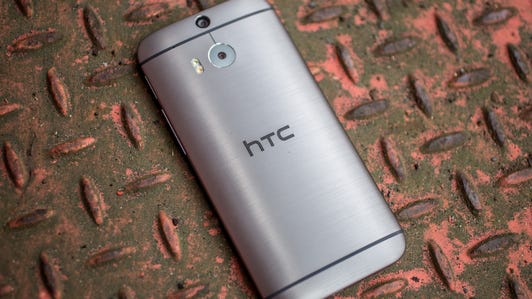





Skeptics, meanwhile, will look at the M8 and complain that it isn’t dramatically different from its predecessor. Superficially, it isn’t a huge leap. The changes to the M8 are subtler, requiring you to hold the phone to truly appreciate the improvement. HTC believes it is building up its identity using its best asset: the eye-catching look of its phones.
“We felt like we had done something right here, and we wanted to harvest as much of it as we could,” Croyle said of the look of the original One.
CNET talked to Croyle to get the inside story on what went into the creation of the M8.
Metal head
By December 2012, a few months before the February launch of the HTC One, Croyle and his team were already pitching ideas for the next phone. At that early stage, the goal was coming up with a single priority, a guiding light for the engineering and design teams to work toward.
For Croyle, it was simple: eliminate as much of the plastic in the phone as possible. They knew the design of the One would be a winner, but were bothered by the plastic that lined the sides, top, and bottom of the phone. At that point, he floated the idea to make sure it was even physically possible.
In case you’re wondering why there are so few metal phones out there, it’s because metal and radio signals don’t play nice with each other. The metal interferes with radio frequency signals, killing any chance for a phone call or data exchange.
Samsung and LG executives have previously told CNET that each had considered metal designs, but opted to stay with plastic because they couldn’t guarantee the reliability of the signal. In addition, it’s more costly, an increasingly important issue if you’re shipping tens of millions of phones.
Even the iPhone 5 and 5S’s aluminum back has two strips of glass on the top and bottom to allow for the transmission of signals.


Sarah Tew/CNET
When HTC launched the One last February, it showed off a back cover that was virtually all metal, with only lines of plastic that offered a clear reception for the antennas housed in the device. Counting the edge of the phone, aluminum accounted for 70 percent of the back housing, according to Croyle.
You would think that the team would have taken a victory lap after the launch, but Croyle said he and his team was back at work on the M8, with development in full swing at that point. By pushing the metal construction to extend to the edges, right up to the glass, he was able to get the housing to 90 percent metal.
The manufacturing process involves carving out the full aluminum housing with gaps where the strips should be. Then, plastic is injected into those gaps, and the entire body is machine-finished, allowing for a body that fits together without any gaps.
The primary color for the M8 is a gunmetal-gray with a hairline finish, with champagne and silver the alternate options. Because of the difficulty of applying unique finishes to 3D shapes, Croyle said the company had to create a process where it had to polish the aluminum back to a mirror finish, and then apply a second hairline finish on top. The process came after testing thousands of variations that included different levels of polish, color, and anodization of the metal.
“The result is this really beautiful finish that feels amazing and really looks amazing,” Croyle said.
Coming into focus
While Croyle was working on refining the design of the phone in the summer, a separate team was pushing to incorporate their idea of embedding two camera lenses into the phone.
HTC has separate smaller R&D teams working on concept projects that may or may not make their way into consumer products. For example, the Boomsound stereo speakers that made their debut in the One came out of an independent team, and wasn’t originally intended for that phone.
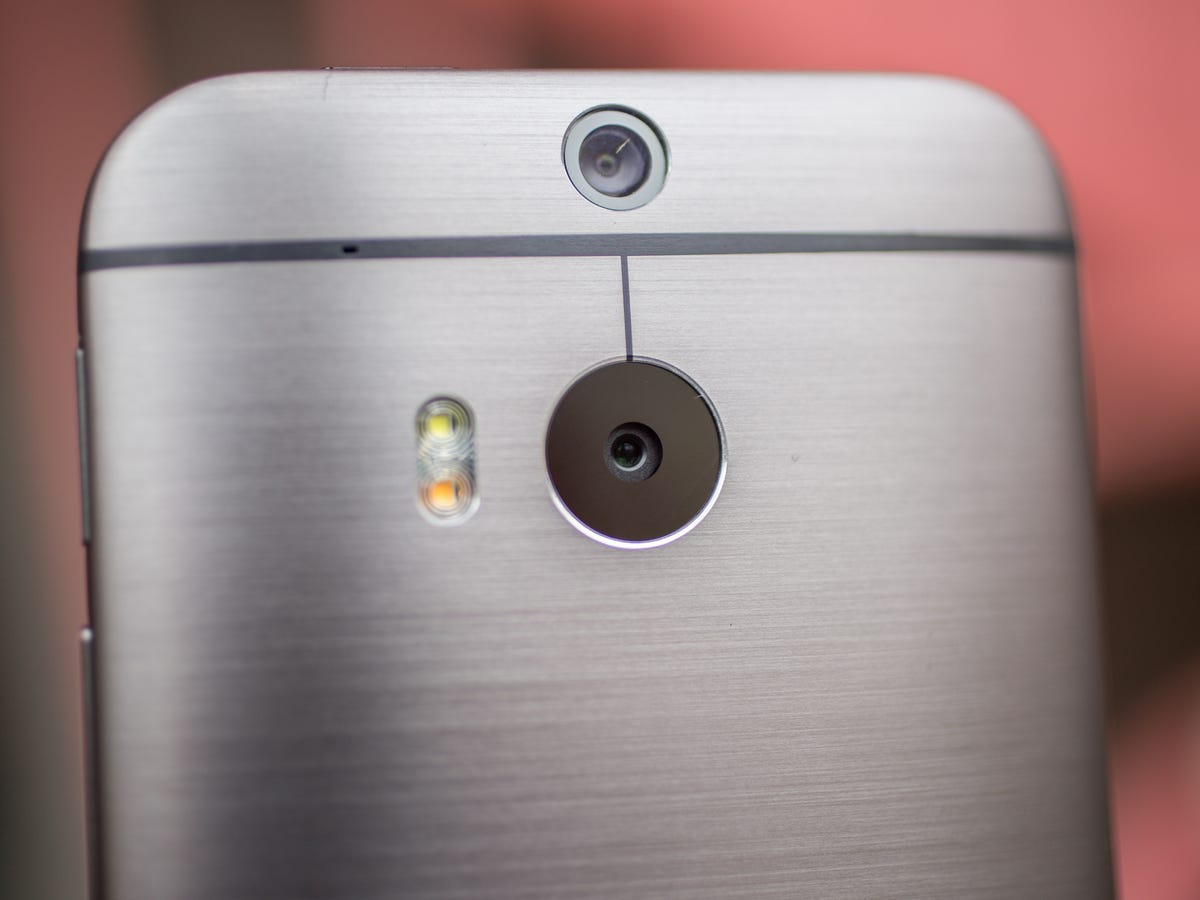

Andrew Hoyle/CNET
For the past one to two years, another team had worked on idea of utilizing the second lens to capture depth, allowing for Lytro-like shifting of focus after the shots were taken. After some trials and tests to see how consumers would use it and to ensure it wouldn’t come off as a gimmick, the company opted to incorporate it. Fortunately, Croyle had reserved space in the back of his design, just in case.
HTC was clearly sprinting toward the finish line, with some of the more interesting features emerging late in the game. The unique flip cover, with holes that allow for the screen to display basic bits like time and weather in large, colorful graphics, came out out of Croyle’s team in December. CEO Peter Chou saw it during a meeting, and liked it so much he insisted on getting it into production. Croyle warned of shortages for the cover, noting the company is already having trouble meeting the early orders.
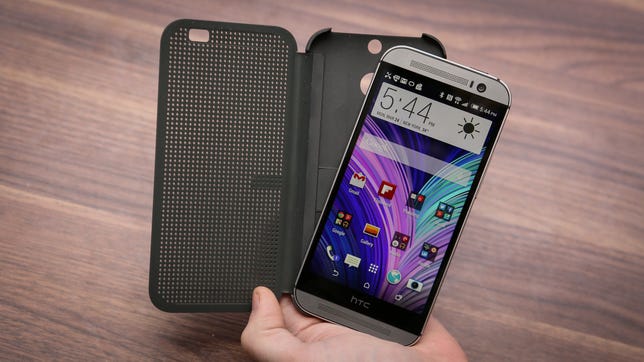

Andrew Hoyle/CNET
Three to four months ago, Chou tapped the engineering team to create an “Extreme Power Saving” mode that promises to keep your phone running for an additional 15 hours despite having only 5 percent battery life. It’s a feature developed so late that it’s still in carrier testing in the US and won’t be available at launch.
Croyle credits Chou’s hands-on direction, and teases he refers to him more as the chief design officer than CEO.
“That’s the benefit of Peter,” he said. “Having somebody who has the respect of the entire organization and can get them to pivot on a single idea.”
Chou has recently taken a more active role in the product side of HTC, leaving much of the day-to-day business and marketing responsibilities to Chairwoman Cher Wang.
A common DNA
Croyle hinted that we would see the fruits of Wang’s increased focus on the marketing strategy.
HTC’s ability to properly promote its products and get its name out to consumers remains its biggest weakness. Even when HTC opted to make a splash by signing Robert Downey, Jr. to as a pitchman, the campaign fizzled and derided as confusing and ineffective. It remains to be seen how Wang will do things different, but it whatever it is, it will have to be bigger and smarter.
“It’s not a product problem,” said Ross Rubin, an analyst at Reticle Research. “The marketing has continued to be challenging.”
Croyle early on pitched a common DNA with the One, retaining the large “forehead and chin” on the front of the phone, which houses the front-facing Boomsound speakers. Chou was on board early.
Croyle compared his decision to the strategy that premium automakers employ with similar design element year after year. Think the gull-wing doors found in Lamborghinis or the kidney grille on the front of every BMW.
The mass-market Desire smartphones also share a consistent visual appearance as the One and M8, even if they lack the premium materials. Croyle added that the lower-end phones would do the same.


Aloysius Low/CNET
Croyle said the additional product portfolio — which he hopes will lead to more shelf space in stores — will help give confidence to consumers looking at HTC that this is more than a one-trick pony.
Still, its marketing position is so weak that it has some wondering whether going with a broad set of carriers makes sense. Roger Entner, a consultant for Recon Analytics, believes HTC would should have signed an exclusive deal with a single major US carrier and bargained for a larger promotional push and store shelf space.
“You’re better off making one of your excited about your product that try to be everyone’s darling,” he said.
As it stands, none of the carriers are particularly interested in aggressively promoting a smartphone that is widely available. In fact, most of the carriers nowadays seem more interested in talking about their networks than about phones in general.
HTC One was a success. Really
HTC, for its part, believes the One has already done its job of building momentum for the M8 and its eventual comeback.
“If I think about where we would be without the HTC One, it would be a pretty disastrous story,” Croyle said. “It actually is our best selling product of all time.”
Entner, meanwhile, gave the One the slightly oxymoronic characterization of “financially underwhelming success.”
For a while, the HTC One was its sole product, only later being joined by the One Mini and One Max. This year, HTC is fleshing out its portfolio for more products, which could help reverse its flagging revenue. Still on tap are budget smartphones better able to tap into the growth of the emerging markets.
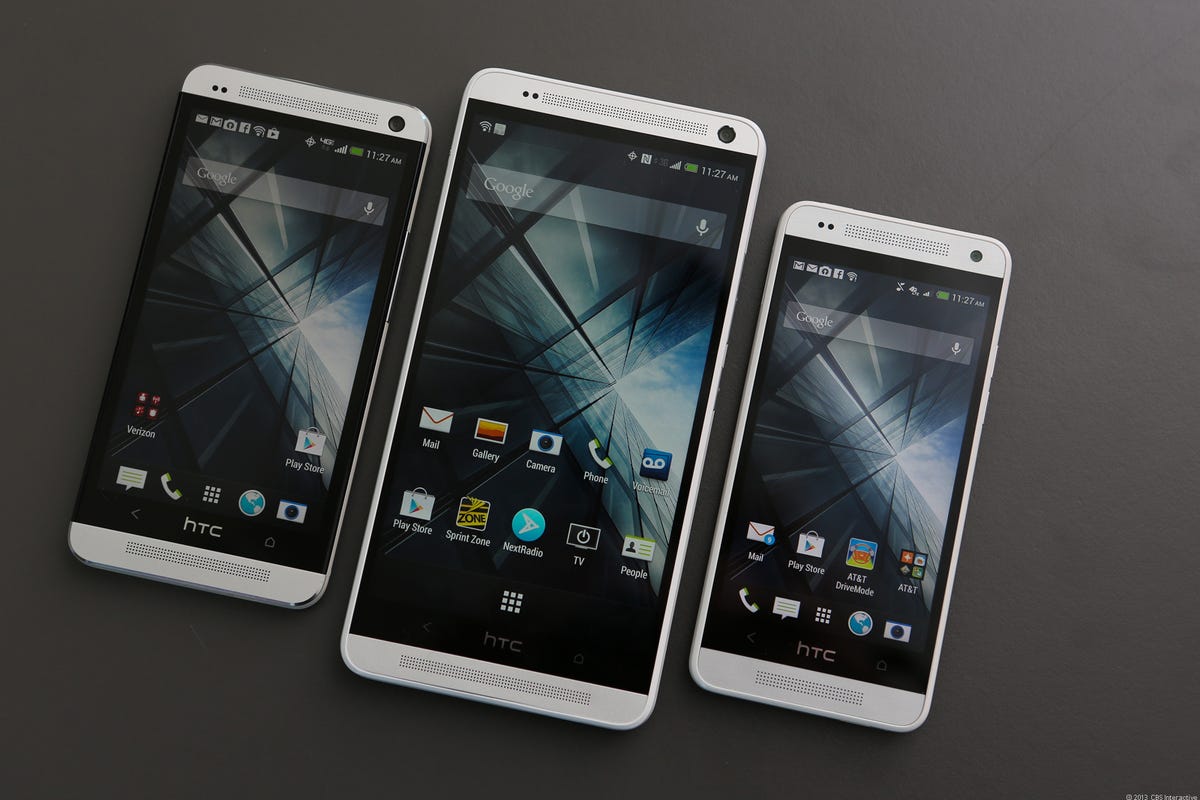

Josh Miller/CNET
HTC is also hoping to erase some of the hiccups of last year. Croyle said there wouldn’t be the same inventory issues that halted the momentum of the One a year ago. It also has the major carriers, AT&T and Verizon Wireless, signed up for the launch (Verizon waited months before carrying the One).
But it is launching against the juggernaut that is the Samsung Galaxy S5. And with Nokia getting scooped up by Microsoft, HTC is one of the last major pure smartphone makers in the market, with the rest of the major players all steeped in other businesses, whether it is networking equipment, computers and tablets, or mobile device components.
Despite HTC’s optimism, one can’t help but to have doubts about its prospects given the overwhelming competition it faces.
“The fat lady is clearing her throat,” Entner said.
When asked if the M8 represented HTC’s do-or-die moment, Croyle offered a neutral, but ultimately unsatisfying, answer.
“I take every phone as a make-it-or-break-it phone,” he said. “Maybe I’m too old, but I have a more even approach. We have to push every single product to make sure it’s the best.”
That’s a great philosophy to have. But good intentions can often be swept away by multi-million-dollar ad campaigns and institutionalized hype of larger competitors. HTC faces some tough odds in avoiding that fate.



